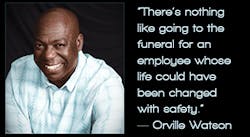For those living in Florida, a state known for its extreme weather, residents have to prepare for the unexpected.
In that way, the coastal state is the perfect place for Orville Watson to call home.
The 15-year safety industry expert thinks about safety and preparedness on and off of the clock.
"When you're in the industry, you don't just think about it at work, you think about it at home," Watson said. "You recognize hazards that most people probably don't realize."
The safety administrator for the Orange County (Fla.) Utilities Department, Watson is part of a team responsible for the safety of 900 employees. On any given day, he deals with the wastewater group, the roadway crews or new hire safety training.
"My day is very fluid," he said.
That diversity of experience makes him somewhat of a safety superhero at home. He plans and prepares for the worst and, as a result, his family is ready for anything.
"I don't look at one step. I look at five steps," Watson said.
Every May or June as hurricane season nears, Watson gathers his family – not just his wife and kids, but also parents and uncles – and they all develop a plan. They select a safe meeting place and go over the necessities for an emergency, such as having a three-day supply of water and keeping any mandatory medications in a plastic bag.
He shares tips about defensive driving with his wife and son. He warns his father about a television that had been mounted just a bit too low.
"My career in safety, it has definitely changed my personal life," he said. "I guess when you're in an industry, you look at things differently."
Because safety permeates his personal life, professionally his enthusiasm is apparent. And that's why Watson is able to share his excitement about safety with those around him.
Like many in the field, he didn't plan to become a safety professional.
Watson had been working in the parking enforcement division of the Department of Transportation in New York City when a training position became available. At the time, he didn't know it was a safety training position, but applied because he wanted to get back into
training, an area for which he had a passion.
After getting the job, he poured himself into learning everything that he could about safety – scouring the OSHA website and reaching out to other professionals in the field – and then finding ways to develop a creative curriculum that would engage employees.
Employee Engagement
As a safety trainer in New York City, he filled his training sessions with interactive games. He quizzed employees using a Jeopardy and a Family Feud format, encouraging them to answer and then supplying them with the correct answer and an explanation if they were wrong. The games allowed him to simultaneously get everyone involved and to check material retention.
He also purchased safety briefing tools like eyeballs, hands and feet that he would throw on the table and challenge employees to give injury prevention tips for each body part.
"It really livened up the class…It broke up the monotony," Watson said. "Safety can be boring, very technical."
Making that material interesting to this blue collar audience, men and women who worked on the roads and repaired the bridges, was crucial, he said.
In his traffic control class, Watson used a tabletop road map and a set of corresponding cones, barrels and barricades to test workers. He would pose a scenario – for example, what to do when you need to close a lane on a 55 mph highway – and task those in the class with setting up a safe work zone.
But beyond that, he found one of the most effective methods of imparting safety knowledge was just by going with the crews and showing them how to do things safely.
The key, however, is in maintaining respect. In Florida, when Watson sees something unsafe occurring with a road crew, unless there's a situation of imminent danger, he will pull the supervisor aside and correct him.
"A lot of it is about approach," Watson said.
He urges supervisors to set examples for their employees, and to lead a safe culture. Oftentimes, it just takes sitting down with workers and showing them the pros and cons of safety.
"The whole thing about safety is building trust," Watson said.
He tries to involve employees in the safety process and encourage them to make suggestions to improve operations. And each year in his current position he invites managers to send representatives from each of the seven divisions of the utility department to help revise the safety manual.
"I want our guys to go home to their families," Watson said. "There's nothing like going to a funeral for an employee whose life could have been changed with safety."
Unfortunately, in his career, Watson has had to experience fatalities on the job. In one instance, the man who was killed had skipped scheduled safety trainings. He died one week before he was once again booked to take safety training.
"I realized what I do," Watson said. "My passion for safety training was ignited."
Seeing employees change behaviors and embrace a culture and attitude of working safely, in fact, has been what has defined his career in the long run.
"It's good to walk and to see the message that you're looking to send is being received and being received positively in the work environment," Watson said.
This is the first story in an ongoing series – Voices of Safety – in which we will profile various safety professionals. If you're interested in participating or would like to nominate someone, please contact Associate Editor Ginger Christ at [email protected].

